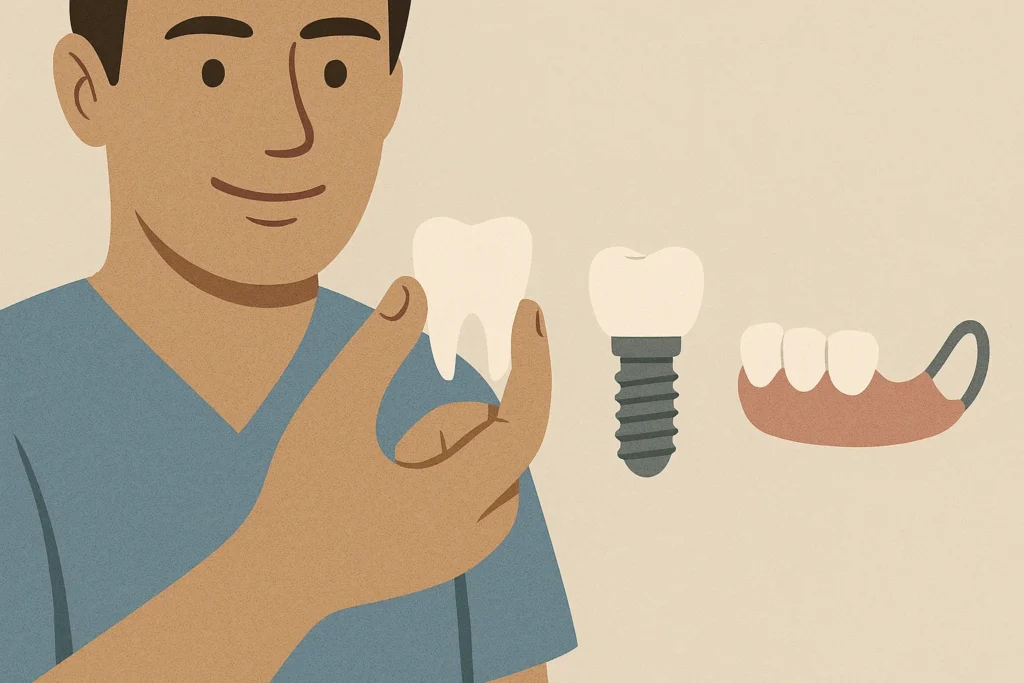Comparing Insurance Plans for Implant Coverage.
Choosing the right insurance plan for dental implants can be a game-changer in affordability and access. The process requires careful attention to coverage specifics, waiting periods, and out-of-pocket details that could significantly affect your treatment timeline and finances.
Not all dental plans treat implants equally. One plan may cover 80% of the surgical cost but nothing for the crown, while another may cover the crown but not the abutment. Understanding these distinctions prevents unexpected costs and helps patients choose plans that deliver the most value based on their specific treatment needs.
Waiting periods are another crucial factor. Some policies may delay implant-related coverage for six to twelve months after enrollment. Patients requiring urgent tooth replacement could find themselves stuck in limbo without proper planning. Choosing plans with minimal or no waiting periods supports timely treatment and sustained oral health.
Beyond the obvious financial elements, it’s essential to assess other comparative factors. Consider annual implant coverage limits, whether out-of-network care is allowed, and the insurer’s reputation for customer service. A plan that looks affordable upfront might be frustrating in the long run if it causes delays or limits your provider options.
Understanding Dental Implant Insurance Coverage
It’s not just about whether dental insurance covers implants—it’s about understanding how much of the treatment is covered, what remains out-of-pocket, and how policies differ across providers.
Some insurance plans may only cover components like the crown, abutment, or preliminary treatments, leaving the surgical implant placement as an out-of-pocket cost. Others may reimburse a percentage of all parts, but only up to a capped annual limit. Knowing these breakdowns up front is key to managing financial expectations.
Out-of-pocket costs vary widely. Many policies impose deductibles and annual maximums that can be exhausted with one implant procedure. Patients must calculate their expected coverage using detailed policy information—comparing plan contributions (like 50% reimbursement or $1,000 cap) with estimated costs.
Lastly, insurance coverage for implants is far from standardized. Some policies may exclude implants altogether, while others might treat them as cosmetic. Confirm how your plan classifies implants—restorative or elective—and explore supplemental options or flexible financing where needed.
Evaluating the Financials of Dental Implants
Dental implants are an investment in oral health and confidence—but they’re also one of the most expensive dental procedures. Understanding typical pricing, how insurance views implants, and what costs you’ll need to cover personally prepares you for a smoother financial journey.
The average cost of a single dental implant can range between $3,000 to $5,000, depending on your location, provider, and the complexity of your case. This includes the surgical placement, abutment, and crown, and may not include bone grafting or additional procedures.
Many insurers categorize implants as cosmetic or elective treatments, not medically necessary. This designation often restricts coverage or leads to outright denial of claims. Knowing how your provider classifies dental implants helps manage your expectations—and encourages looking for alternatives like health savings accounts or discount plans.
These gaps in coverage leave most patients responsible for a significant portion of their care. Understanding your total financial responsibility early on allows you to consider options like in-house payment plans, financing through third-party lenders, or dental discount memberships that can reduce overall expenses.
Navigating the Complexities of Dental Insurance for Implants
Insurance plans are full of nuances that can make or break your implant financing experience. From annual maximums to procedure exclusions, every detail matters. Knowing how to read and respond to these clauses ensures you won’t be caught off guard.
Annual maximums—usually between $1,000 to $2,000—often cover just a fraction of a single implant procedure. If you need multiple implants or preliminary procedures, these caps can be exhausted quickly. Understanding how to structure your treatment to span calendar years can help stretch your benefits further.
Implants are commonly excluded or partially covered. For example, some plans may cover the implant post but not the crown, or limit the number of implants per lifetime. It’s essential to review your plan’s fine print and ask direct questions of your provider or insurance liaison.
To navigate these complexities, you’ll want to verify how your plan defines implants (cosmetic vs. restorative), whether a pre-authorization is required, and how your deductible or co-pay factors into the final reimbursement. Having clarity in these areas makes it easier to develop a financial strategy.
Selecting the Best Insurance Plan for Dental Implants
Not all insurance is created equal. Selecting the right dental plan is critical to controlling the cost of implants. By evaluating plan types, waiting periods, and hidden trade-offs, you can find coverage that meets your health and financial goals.
Dental PPOs, for instance, often offer the widest provider networks and partial implant coverage. However, you’ll still need to compare specific plan details. Look for differences in reimbursement percentages, premium costs, and whether implants are treated as basic or major procedures.
Waiting periods remain a key differentiator. Some plans require six months to a year before covering implants. Patients who need faster treatment should prioritize plans with minimal or waived waiting periods.
Finally, assess all plan features, from annual limits to the breadth of the dental network. A plan that offers low deductibles or no annual cap might offset a slightly higher premium. The ideal choice balances cost, convenience, and coverage for implant procedures.
Understanding the Advantages of Dental Discount Plans
If traditional insurance doesn’t meet your needs, dental discount plans can provide affordable access to implant care. These membership-based programs offer predictable discounts, faster access, and flexibility that many insurance plans can’t.
Discount plans usually offer 15–60% off standard rates for services including implants, without pre-approvals or claim denials. Members can access these benefits immediately, making it ideal for urgent or uncovered needs.
Unlike insurance, there’s no waiting period. Patients can begin treatment as soon as they enroll, avoiding long delays and receiving timely care. This is particularly beneficial for patients who need restorative work after tooth loss.
Transparency is a major perk. With fixed-rate discounts and upfront costs, you know exactly what you’ll pay, which simplifies budgeting. Dental offices like Laguna Heights Dental often recommend these plans when traditional insurance falls short.
Assessing Dental Implant Coverage for Seniors
For seniors, navigating implant coverage through Medicare and Medicaid presents unique challenges. These programs typically don’t cover implants, but alternative strategies exist for those over 65.
Medicare Part A and B do not cover routine dental care or implants. Some Medicare Advantage (Part C) plans offer limited dental benefits, but these vary widely. Seniors interested in implants may need supplemental insurance or alternate financing methods.
Non-profit programs and state-level senior assistance funds may provide financial support. Additionally, organizations like Dental Lifeline Network or local dental schools often offer reduced-cost services for qualifying seniors.
Flexible funding options such as in-house dental financing, third-party loans, and dental discount plans provide relief for seniors. At Laguna Heights Dental, we help older adults explore these options and design realistic plans to fund their care.

Finding Financial Solutions for Dental Implants Outside of Insurance
When insurance isn’t enough, flexible financing makes dental implants more accessible. Patients can take advantage of financing plans, office payment programs, and custom budgeting to manage expenses effectively.
Third-party financing options such as CareCredit or LendingClub allow patients to spread out payments over time, often with low or no interest depending on the term. This enables you to begin care immediately without upfront barriers.
Dental practices like Laguna Heights Dental often offer in-house payment plans tailored to patient needs. These plans provide flexible installment options, aligning treatment with your budget without delaying care.
Supportive dental offices assist with cost breakdowns, insurance navigation, and financing paperwork. This patient-first approach ensures no one is denied necessary care due to financial uncertainty.
Strategizing Financially for Dental Implants
A coordinated strategy is key to reducing the cost burden of implants. Patients who combine insurance benefits, discount programs, and financing options often achieve the best outcomes.
First, consult your dental provider’s billing team to identify how to maximize insurance coverage. This might include splitting treatment across two years, bundling covered procedures, or submitting pre-approvals.
Second, combine resources strategically. You may use an HSA to fund implant-related costs, a dental discount plan to lower service prices, and a payment plan to stretch expenses over time.
Lastly, create a comprehensive financial roadmap. Document all costs, payment options, and expected timelines. Laguna Heights Dental helps patients create these plans to ensure implant procedures are not delayed due to financial concerns.
Developing a Financial Plan for Dental Health at Laguna Heights Dental
At Laguna Heights Dental, we believe that access to dental implants shouldn’t be limited by financial barriers. We work with patients to customize payment options, insurance support, and education on financing.
We begin with patient education, explaining the pros and cons of different insurance plans, discount memberships, and financing solutions. This helps you understand the tools available to manage implant costs effectively.
Next, our team navigates insurance benefits with you. We explain policy terms, verify coverage, and assist in filing claims to minimize confusion. We also identify supplemental insurance or discount options to enhance affordability.
Finally, we help construct a financial plan tailored to your needs. Whether it’s phasing treatment, applying for financing, or combining multiple tools, we create a strategy that aligns your goals with your budget.
Fulfilling Your Dental Healthcare Needs Wisely
Making smart financial decisions starts with knowing your insurance and ends with finding the best support. At Laguna Heights Dental, we empower you with tools, options, and confidence to pursue the care you need.
Understand your policy: Review what’s covered and what isn’t. If your plan only covers part of the implant or excludes it entirely, we help find alternatives.
Explore discount plans: They offer fast, reliable savings without red tape. Ideal for patients who need immediate help or who don’t qualify for traditional insurance coverage.
Lean on our team: Our dental experts are here to assist with payment options, paperwork, and strategy. You’re never alone when planning your care at Laguna Heights Dental.
Ready to Talk About Your Smile?
If you’re thinking about getting a dental implant or concerned about one you already have, we’d love to talk. Schedule a consultation at Laguna Heights Dental, and let’s create a plan that gives you peace of mind.
Your smile deserves support that lasts a lifetime—and we’re here to help make that happen.
Schedule your consultation Today!
Laguna Heights Dental
30231 Golden Lantern, Ste D
Laguna Niguel, CA 92677
(949) 363-1200
https://lagunaheightsdental.com/
See More Reviews From Laguna Height Dental. View information about local places in our community. Get Driving Directions to Our Practice
Frequently Asked Questions
Does dental insurance usually cover implants?
Most insurance plans have limited coverage for implants. They may consider them elective, so always check the fine print. Dental discount plans may be a helpful alternative.
What options exist for seniors?
While Medicare and Medicaid often don’t cover implants, seniors can look into Medicare Advantage plans, payment plans, and non-profit assistance programs for help.
Are dental discount plans effective?
Yes, they provide immediate discounts with no waiting periods. They’re often the most affordable option when traditional insurance is unavailable or insufficient.
Related Articles
Preparing for Dental Implant Surgery, After Care for Implants, Dental Implants Pricing Guide, Implants Vs Traditional dental, Traditional Dental Implants, Dental Implants, Same-Day Dental Implants, Affordable teeth implants, Dental implants surgery, Dentures with implants, Full Mouth Dental Implants, Mini Dental Implants, Zirconia Dental Implants, Dental Implant Success, Dental Implant Types, Dental Implant Candidates, Dental Implant Complications, Dental Implant Maintenance, Dental Implant Cost Factors, Dental Implant Failure





